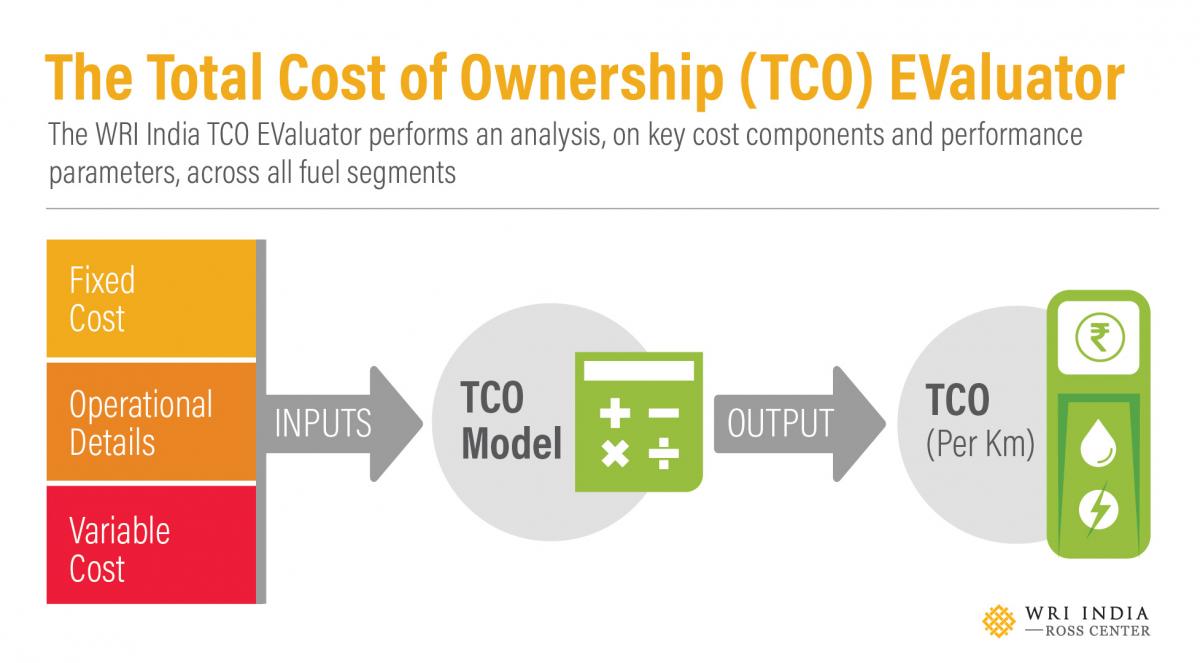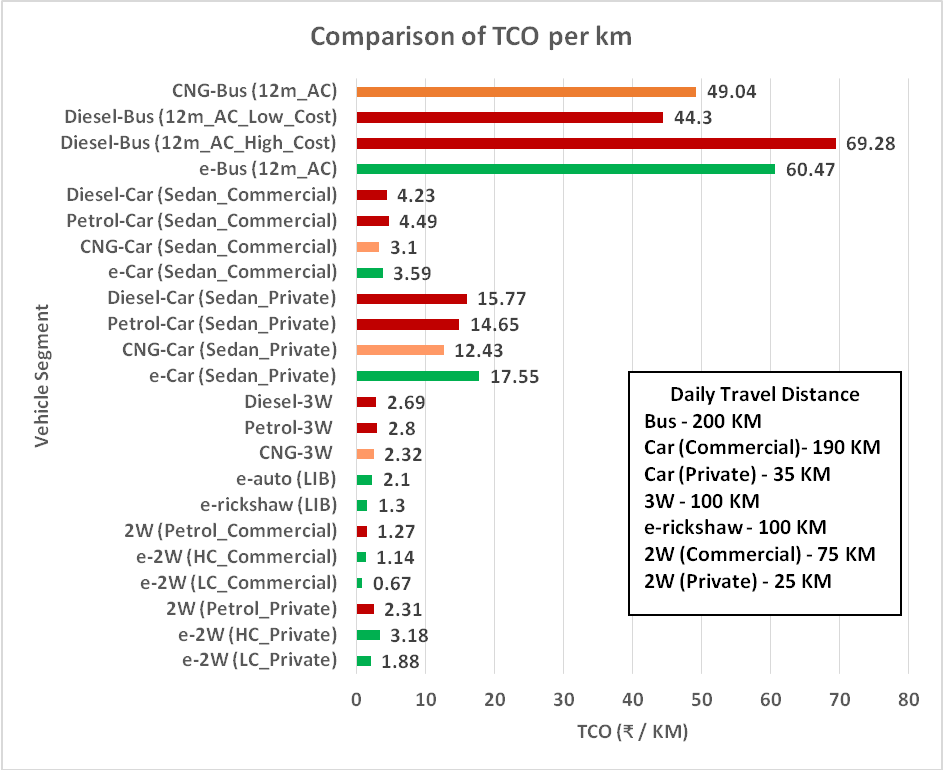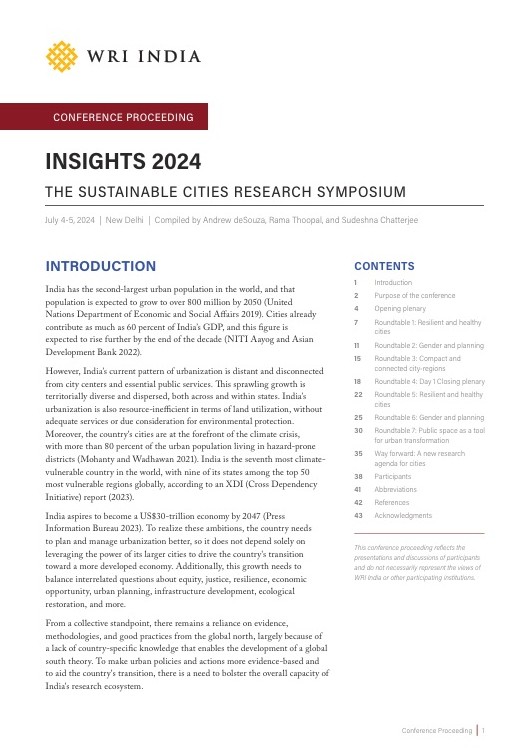Total cost of ownership of electric vehicles: Implications for policy and purchase decisions
by e -
Globally, and in India, the COVID-19 pandemic has temporarily interrupted the strong growth of the electric vehicles market. In the coming days, it will be important to regain this momentum in order to advance the decarbonization of transport.
The transport sector is responsible for 24% of global energy-related CO2 emissions, of which almost three-fourths is due to road transportation. At the local level, tailpipe emissions are significant sources of air pollution killing an estimated seven million people every year. Electric vehicles help reduce these emissions, more so as electricity grids worldwide move towards a greater share of renewables for power generation.
India’s steadily growing EV Market
For India, with its low rates of vehicle ownership, electric vehicles offer the prospect to leapfrog the traditional fossil-fuel driven motorization to more sustainable transportation systems. Recognizing this opportunity, the Government of India is supporting various policies and schemes to improve the competitiveness of the electric vehicle (EV) sector, for consumers and manufacturers alike. While sales have been growing steadily, EVs still comprise a marginal component of all vehicle sales. Of the 215.46 lakh automobile sales in 2019-20 only 1.56 lakh were electric vehicles.
Price - The key barrier to purchase
A key barrier to EV adoption, particularly in India’s price-sensitive automobile market, has been the higher purchase price. However, advances in battery and power component technologies and growing economies of scale are pushing EV prices down. A wider range of EV models is also expected to be launched in the coming years, offering more affordable options for consumers. Additionally, expenditure on fuel and maintenance are lower for EVs than for internal combustion engine (ICE) vehicles.
The EV advantage – Gauging the total cost of ownership
A more accurate assessment of the economic efficiency of EVs vis-à-vis ICE vehicle is the ‘total cost of ownership (TCO) that is the sum of all costs involved in the purchase, operation and maintenance of a given asset during its lifetime. A comparative TCO analysis of electric vehicles and ICE vehicles offers valuable insights for decision makers in various roles, including policy makers, fleet operators and prospective vehicle owners:
- For policy makers, the TCO analysis offers evidence to design the right-sized financial incentives to spur EV adoption.
- For fleet owners and operators, it provides an assessment of economic viability to support a business transition towards electric vehicles.
- For consumers, the TCO analysis can support purchase decisions that are based on the lifecycle costs of owning and operating the vehicle.
Combined with a sensitivity analysis that highlights the impacts of key usage parameters, the TCO analysis can be tailored to assess viability in a variety of use cases. It can also help shape better policy frameworks and business models at different stages of EV penetration within the transport sector.

Total cost of ownership (TCO) analysis parameters
View the recording of our recent webinar and panel discussion.
WRI India conducted a comparative TCO analysis of electric two-wheelers, three-wheelers, cars and buses in the Indian market, against their ICE variants running on petrol, diesel and CNG fuels. A sensitivity analysis was also conducted, based on vehicle usage patterns, to understand the relative performance of EVs in comparison to ICE variants over time and at different levels of daily utilization.
The TCO model utilizes three categories of input parameters — the capital cost, operational cost and vehicle usage details:
- For capital cost, input parameters include vehicle purchase cost, discount rate, financial incentives applicable, resale value and miscellaneous cost.
- Operational costs comprise of fuel/electricity, maintenance, staff cost and miscellaneous cost.
- For vehicle usage details, parameters considered are the vehicle holding period, average kilometers driven per day, and number of operational days in a year.
More details about the assumptions, values and calculations used in the TCO analysis model are available in the paper by Parveen Kumar and Subrata Chakrabarty.

Figure 1 presents a snapshot of the results from WRI India’s TCO analysis, disaggregated for different vehicle segments (over a ten-year holding period) at typical travel distances assumed for each segment. Five key findings from our TCO analysis
i. Electric two-wheeler and three-wheeler vehicle segments are already economically competitive. In the two-wheeler (2W) and three-wheeler (3W) segments, EVs are more economical than their ICE counterparts. For commercial use cases, with an assumed daily utilization of 75km and 100km for 2Ws and 3Ws respectively, all electric models considered have a lower TCO per km than the ICE variants. For private utilization of 2Ws, with an assumed daily utilization of 25km, we find that the lower-cost electric models are still competitive against the petrol models while the higher-cost electric models have a slightly higher TCO per km.
ii. Electric cars are economically viable for commercial fleet operations. The TCO analysis demonstrates that electric cars are ready to be inducted in commercial fleets with high daily utilization. A typical fleet car travels about 190 km per day, on average; in comparison, the breakeven distance per day for an average electric sedan is 164 km per day. Breakeven distance is defined as the distance at which the electric vehicle has a lower TCO per km than its fossil fuel variants. Electric cars for personal use however, still require financial incentives to be economically viable.
iii. Electric buses require a high daily utilization to achieve economic viability. The focus on electrification of the public transport bus fleets is essential for future-proofing long-term capital investment decisions. However, for a typical daily utilization of 200km, electric buses currently have a higher TCO per km than diesel (low-cost models) and CNG-fueled buses. The TCO per km for electric buses is INR 60.47, as compared to INR 69.28 for high-end diesel buses and INR 44.30 for low-cost diesel buses. For electrified public transport fleets to be economically competitive for transit agencies, electric buses need higher utilization or financial incentives to lower capital costs.
iv. Higher vehicle utilization results in a steeper drop in TCO per km for electric vehicles. Lower fuel and maintenance costs result in greater savings for electric vehicles as vehicle utilization increases across all vehicle segments. For every extra kilometer driven, the TCO per km for EVs shows a greater reduction in comparison to ICE vehicles. This means that higher daily utilisation and/or a longer vehicle holding period can deliver greater savings for EV users — even after accounting for battery replacement.
v. Recurring, non-financial incentives can help prioritize electric vehicles that are yet to achieve parity in TCO per km. Incentives such as toll fee or congestion fee waivers, reserved parking, exemptions from permit restrictions, permitted entry in low-emission zones and exclusive bus lanes can complement financial incentives and drive preference for electric vehicles in segments that have yet to achieve TCO parity with ICE vehicles. Such incentives may also contribute to EVs becoming economically competitive. For instance, in the case of electric buses, exclusive bus lanes allow buses avoid congestion and cover higher daily distances that reduces their TCO per km. In addition, non-financial incentives can increase EV penetration even in economically competitive segments such as 2W and 3W.
This is the first blog in a series on TCO analysis of electric vehicles in the Indian market. In the upcoming blogs, we will focus on the findings of the TCO analysis for each vehicle segment, to demystify the total costs of owning and operating EVs for individuals and fleet operators, analyze the role of financial incentives and vehicle utilization patterns, and highlight specific implications for policy makers and manufacturers.
Visit our TCO EValuator page to easily calculate the TCO for various vehicle segments and use cases.
The views expressed here are the authors’ own.


